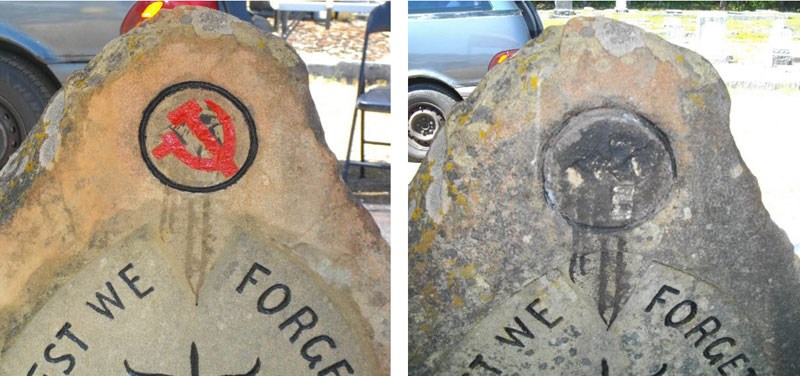Just in time for this weekend’s Miners Memorial festivities, somebody vandalized Ginger Goodwin’s grave.
Whoever did it snuck into the Cumberland cemetery and chipped the hammer and sickle right out of the labour leader’s headstone.
It wasn’t the subtlest of political statements — but then, there hasn’t been much subtlety to the century-long ideological tug-of-war over the labour leader’s legacy.
Albert (Ginger) Goodwin was — and is — a polarizing figure. A fire-breathing socialist, he became a legend for his activism in places like Trail, where he led a strike at Cominco in 1917, and Cumberland, where he took on the coal barons.
Cumberland is also where the 31-year-old was buried after being shot dead in the nearby forest in July 1918. He was killed by special constable Dan Campbell, a Victoria hotel owner deputized to track down Goodwin after he slipped off to the bush rather than be conscripted into the army during the First World War, a conflict he viewed as a fight between capitalists.
Campbell claimed self-defence, but few in the labour movement bought that. They saw Goodwin as a martyr. Â鶹´«Ă˝Ół»workers downed tools in a one-day general strike, Canada’s first.
A massive crowd, including returned soldiers wearing their medals, turned out for Goodwin’s Cumberland funeral procession.
Although regarded as a hero within the labour movement, Goodwin might have faded in public memory had successive New Democrat and Liberal governments not engaged in the War of the Highway Signs.
That struggle began in 1996 when the NDP government of Glen Clark, acting at the behest of the organizers of Miners Memorial Day, an event dedicated to the 295 miners who died in Cumberland’s collieries, designated an 11-kilometre stretch of the new Inland Island Highway as Ginger Goodwin Way.
Ah, but they did so without consulting Cumberland village council, which bristled at the notion of venerating a man some saw as a draft-dodging extremist.
Council suggested the name Miners Way as a less-controversial alternative — a proposal the NDP greeted with all the warmth of a Canucks fan bumping into Brad Marchand in an elevator.
By contrast, after taking power in 2001, Gordon Campbell’s Liberals barely had time to figure out where the legislature washrooms were before rushing to remove the Ginger Goodwin Way signs.
Alas for them, Ginger proved harder to keep down than Rocky Balboa. Someone plastered Ginger Goodwin Way stickers over Cumberland’s Dunsmuir Avenue signs (the mine-owning Dunsmuirs were less admired up-Island than in Victoria).
Then, last June, just in time for the Miners Memorial weekend and the centennial of Goodwin’s death, the current NDP government erected the Ginger Goodwin Way signs again. (By that point the signmakers must have been getting hand cramps.)
At least the NDP and Liberals kept their mitts off of Goodwin’s resting place — unlike whoever it was who crossed the line of decency and desecrated the headstone this month. No other graves were targeted.
“A lot of people are very angry,” said Robin Holvik, a historian at the Cumberland Museum and Archives. Some wonder if the vandalism reflects the dismal state of modern public discourse, in which the rise of populism and the social-media shouting factory has emboldened people to lash out at, rather than listen to, those with whom they disagree. Or maybe it was just some nut.
The odd thing is, some of Goodwin’s supporters weren’t thrilled with the inclusion of the hammer and sickle on the gravestone in the first place. “Goodwin was not actually a communist,” Holvik said. “He was a socialist, and very proudly so.” The marker wasn’t erected until 1937, having been carved by Cumberland miner Vincenzo Picketti, with the backing of a couple of labour organizations.
As with the efforts to remove Goodwin’s name from the highway, the vandalism might only serve to draw attention to his story.
“When things like this happen, it’s galvanizing for the community,” Holvik said.
She was echoed by Mayor Leslie Baird: “It just makes people who believe in him and what he did firmer in their beliefs.”
It’s a lesson to be learned by politicians and vandals alike. If you want to make someone famous, try burying his name.



